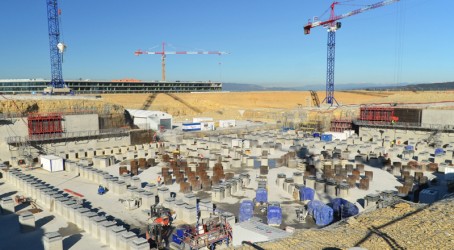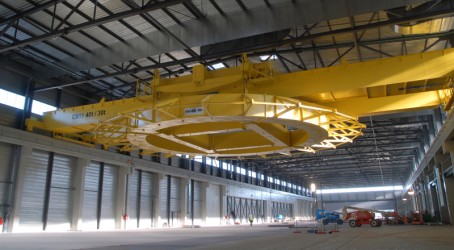In an age where oil prices are soaring, fossil fuels are being depleted and carbon emissions are subject to ever more stringent regulation, the hunt for a sustainable and non-polluting power source is on. The holy grail of this quest is nuclear fusion – harvesting power from the same reaction that occurs in the sun to create light and warmth.
Scientists have been working to experimentally create the reaction for more than 50 years. In the laboratory, fusion involves forcing two isotopes of hydrogen, deuterium and tritium, to collide and fuse with each other and release substantial amounts of energy in the process. This is done in a machine known as a tokamak, which uses magnetic fields to contain and control the hot plasma that harbours the isotopes.
An international collaboration based in Cadarache, southern France, is hoping to prove that fusion can be a clean and sustainable source of power. Known as Iter, it is one of the world’s biggest engineering projects. This year sees it move into an exciting new phase. With many of the designs now finalised, components of the fusion machinery are starting to be manufactured, bringing nuclear fusion one step closer to reality.
At this stage, 75% of the procurement arrangements have been signed. Ken Blackler, head of the assembly and operations division of Iter, says: “Essentially we have handed the ball over to the domestic agencies now and are starting to sign contracts and, in some cases, move into the manufacturing phase for the major components.” Deals are in place for all the key parts of the Iter machine, including the vacuum vessel, the magnets and the buildings.
The remaining 25% of contracts will provide the auxiliary systems that are less urgent and have yet to be designed. These include systems for measuring, diagnostics and data remote handling. Deals for these will be signed within the next two years.
“Everything is running to schedule,” says Blackler. Excavations for the tokamak complex, which will house the Iter machine, have been dug and the concrete base mat has been poured into place. The seismic isolation pads, that will protect the building in the event of an earthquake, are essentially complete. Work is now focused on the retaining walls and anti-seismic bearings that are scheduled to be place by March.
In April, the concrete for the basement of the building will be poured into place. Meanwhile, the 12,000-square-metre building that will house the poloidal field coil-winding machinery is completed. Six horizontal superconducting coils, from eight to 24 metres in diameter, will sit on the outside of one of the magnet structures that stabilises the plasma. These coils are the biggest components of the Iter project. Five of them are too big to be transported in one piece, so will be manufactured on site in the winding building.
Now most of the contracts have been arranged, Iter is moving from the design phase to the industrial stage. Tenders are out for the construction of the remaining 35 buildings on the site. Over the next two years, Blackler’s team will be tendering a further 40 contracts for the assembly and installation of the Iter machine.
Some engineering support contracts have already been signed with UK companies, including Oxford Technologies – which specialises in remote handling equipment, Assystem UK and Amec. Assembly of the tokamak is due to start in 2015, with the installation of the associated plants beginning the year before. The device is set to be finished by 2019.
Licensing of the fusion device with the French nuclear authority has been one of the biggest challenges for the project. “Previously, fusion has always been an experimental device, where you have different constraints. But now we are classified as a nuclear device,” says Blackler. The maturation of the field has meant that safety has become a critical component of the design. “That’s a new thing for fusion,” he adds. Iter hopes to get the decree from the French government to go ahead this year.
As the project moves forward, new skills will be required on site. When the assembly area becomes active, staff skills will have to adjust accordingly. The recruitment emphasis will move from design engineers to installation engineers.

Staff at Iter are recruited in five-year contracts, and this year will see many of these come to an end. The contracts are renewable, but some scientists and engineers may be returning home for personal reasons, and recruitment drives are expected to replace these staff. Jobs for an additional 30-40 people are likely to become available, bringing the total Iter staff to 500.
The biggest recruitment push, however, will centre on contractors. As well as Iter’s in-house staff, around 200 contractors work on site, placed by companies such as Jacobs and Assystem. In the next two years this figure is set to swell to 3,000 as the assembly phase gets under way. These contractors will form the people power for 40 tokamak assembly-and installation-contracts.
Recruiting this number of people with the necessary skills has always been a worry, says Blackler. “With the economic situation, it may be less of a problem than it might have been. If there is a recession or a weakness in industry, then we hope we can recruit enough skilled people.”
Despite excitement that the project is moving one step closer to completion, challenges still lie ahead. For engineers at Iter, integration of the systems in the available site space is complicated, and work is still going on to ensure the integration of the tokamak machine. The components of the machine are delivered to the organisation from around the world, but responsibility for the design integration and assembly falls to Iter.
“One of the biggest issues is the management of tolerances, loads and forces within the machine and the building,” says Blackler. His team is working with three-dimensional simulation software to model the overall tolerance of the machine. Statistical analysis then helps highlight the interactions between the components. More detailed studies are done on particular areas of concern. The fact that some of the components are installed and maintained by remote handling equipment adds yet another factor. But if his team can successfully tackle all these challenges, they will have moved one step further towards providing a safe, clean energy source.

How does the Iter machine create energy?
At the extreme temperatures within the Iter machine, electrons are separated from nuclei to form a plasma, which is a hot, electrically charged gas. Without this plasma, the light elements of deuterium and tritium would not be able to fuse together and create energy.
The fusion reaction between the isotopes produces one helium nucleus, one neutron and energy. As the helium nucleus carries an electric charge, it is kept in the plasma by the Iter machine’s magnetic fields. But the neutron has no electrical charge so it is unaffected by it and is able to travel to the walls of the machine.
These neutrons carry about 80% of the energy produced in the reaction and transfer this to the walls of the chamber as heat. In Iter, the heat is dispersed through cooling towers and will be used to produce steam that drives turbines and creates electricity.
A physicist’s view
Name: Andrew Davis
Job: Nuclear physicist
Affiliation: Culham Centre for Fusion Energy
Will the Iter project achieve its goals?
Yes.
Scientists have been working on nuclear fusion for some time – how is the Iter approach different?
The scale. We learnt by building the tokamaks preceding Iter – JET in the UK, JT60 in Japan and TFTR in the US – that bigger is better. Particles in the plasma take a while to diffuse from the middle of the device to the edge, so the bigger the machine is the longer it takes for anything to escape the magnetic field. The other thing we learned is that you have to use super-conducting magnets. If you don’t, the current being carried in the copper magnets heats up and it can only operate for so long before the copper gets very, very hot. Often the copper is surrounded by insulator, which could melt. Superconducting magnets let the current flow with no resistance, so you do not get that loss.
What are the major safety concerns of the Iter project?
There are no major safety concerns. Iter is an experiment, but it’s not like a nuclear fission system where there are worries about meltdown. It is so difficult to get the reaction going in the first place that the second that you look away and don’t concentrate on what you are doing, the reaction stops.
A policy expert’s view
Name: Dr William Nuttall
Job: Senior lecturer on technology policy
Affiliation: Cambridge Judge Business School, University of Cambridge
Will the Iter project achieve its goals?
It is extremely likely that it will. It is entirely possible that Iter will demonstrate nuclear fusion by the end of the decade. But what will be really interesting is the date that tritium as a fuel goes into the machine. This is where the project will break new ground. The real test will be whether useful fusion can be delivered. For instance, will the Q factor be of sufficient magnitude to reveal a commercial future for fusion? The Q factor is the amplification factor – the ratio of energy produced to the energy put in. For a useful energy source, the Q factor must be at least an order of magnitude greater than one.
What is the biggest challenge that Iter will have to overcome?
The biggest concern is the magnet technology. From the outset, Iter intended to be a relatively conservative concept that relied on the existence of deployable technology – breakthrough technology would not be needed. The magnet technology is surprisingly challenging. It is not as mature as people hoped it would be.
Why is the project so important?
For many decades, the potential of fusion as a safe and clean energy source has been known. If Iter produces fusion that suggests there is a commercially viable future, the benefits will be substantial.